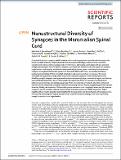Nanostructural diversity of synapses in the mammalian spinal cord
Abstract
Functionally distinct synapses exhibit diverse and complex organisation at molecular and nanoscale levels. Synaptic diversity may be dependent on developmental stage, anatomical locus and the neural circuit within which synapses reside. Furthermore, astrocytes, which align with pre and post-synaptic structures to form “tripartite synapses”, can modulate neural circuits and impact on synaptic organisation. In this study, we aimed to determine which factors impact the diversity of excitatory synapses throughout the lumbar spinal cord. We used PSD95-eGFP mice, to visualise excitatory postsynaptic densities (PSDs) using high-resolution and super-resolution microscopy. We reveal a detailed and quantitative map of the features of excitatory synapses in the lumbar spinal cord, detailing synaptic diversity that is dependent on developmental stage, anatomical region and whether associated with VGLUT1 or VGLUT2 terminals. We report that PSDs are nanostructurally distinct between spinal laminae and across age groups. PSDs receiving VGLUT1 inputs also show enhanced nanostructural complexity compared with those receiving VGLUT2 inputs, suggesting pathway-specific diversity. Finally, we show that PSDs exhibit greater nanostructural complexity when part of tripartite synapses, and we provide evidence that astrocytic activation enhances PSD95 expression. Taken together, these results provide novel insights into the regulation and diversification of synapses across functionally distinct spinal regions and advance our general understanding of the ‘rules’ governing synaptic nanostructural organisation.
Citation
Broadhead , M J , Bonthron , C , Arcinas , L , Bez , S , Zhu , F , Goff , F E , Nylk , J , Dholakia , K , Gunn-Moore , F J , Grant , S G N & Miles , G B 2020 , ' Nanostructural diversity of synapses in the mammalian spinal cord ' , Scientific Reports , vol. 10 , 8189 . https://doi.org/10.1038/s41598-020-64874-9
Publication
Scientific Reports
Status
Peer reviewed
ISSN
2045-2322Type
Journal article
Description
This work for funded by the Biotechnology and Biological Sciences Research Council (BBSRC; BB/M021793/1), RS MacDonald Charitable Trust, Motor Neurone Disease (MND) Association UK (Miles/Apr18/863-791), the Engineering and Physical Sciences Research Council (EPSRC; EP/P030017/1), Welcome Trust (202932/Z/16/Z), European Research Council (ERC; 695568) and the Simons Initiative for the Developing Brain.Collections
Items in the St Andrews Research Repository are protected by copyright, with all rights reserved, unless otherwise indicated.

